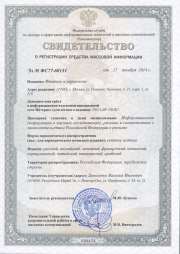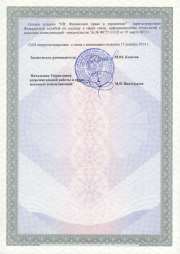MAIN PAGE
> Back to contents
Publications of Shemyakina Marina Sergeevna
|
National Security, 2023-5
|
|
Shemyakina M.S. - Threats to the economic security of the Republic of Mari El in the field of countering the legalization (laundering) of proceeds from crime in the market for the sale of real estate
|
|
pp. 77-89
|
DOI: 10.7256/2454-0668.2023.5.43903
Abstract: The subject of the research is the relations that arise in the process of combating the legalization (laundering) of criminal proceeds in the economy. The author substantiates the need to change the current legislation in terms of classifying self-employed persons who provide intermediary services in real estate purchase and sale transactions as persons who are required to register with Rosfinmonitoring and exercise mandatory control over part of the transactions. In the article, on the basis of the algorithm developed by the author, a check was made of the compliance of realtors and real estate agencies of the Republic of Mari El with the legislation in the field of combating the legalization (laundering) of proceeds from crime. Particular attention is paid to recommendations for improving the mechanism of operation of the Domclick service with realtors and real estate agencies.The scientific novelty of the study lies in the identification of real estate purchase and sale transactions through the Domclick service, which are carried out by real estate agencies that are not registered with Rosfinmonitoring and do not exercise mandatory control over transactions, as well as determining the share of transactions in the primary market that are subject to mandatory control using the example Republic of Mari El. The results obtained contain practical recommendations for changing the current legislation, develop theoretical provisions in terms of ensuring the economic security of public legal entities, and also determine the identification of one of the threats to the economic security of the Republic of Mari El: the threat of legalization (laundering) of proceeds from crime in the market sale of real estate.

|
Taxes and Taxation, 2023-5
|
|
Shemyakina M.S. - Genesis of tax administration tools for "whitewashing the economy"
|
|
pp. 71-86
|
DOI: 10.7256/2454-065X.2023.5.43910
Abstract: The subject of the study is tax relations that arise in the process of interaction between tax authorities and taxpayers and are aimed at inducing the latter to pay taxes and fees established by law. The evolution of tax administration tools for "whitewashing" sectors of the economy and individual objects is considered. In accordance with the content of the tools used, a classification was made into five stages of development: the period of formation and development of tax control; the period of creation of the concept of the taxpayer behavior management system; the period of introduction of new digital technologies that make it possible to identify the latent tax base; a period of increasing the efficiency of using tax administration tools aimed at motivating taxpayers to voluntarily pay taxes and use prices in transactions; the period of development of tax administration tools for the "whitewashing" of individual objects of taxation, including by individual taxpayers, the further development of the Federal Tax Service as a "digital service". The scientific novelty of the study is the development of theoretical provisions in terms of analyzing the historical development of tax administration tools for "whitewashing the economy". The definition of the concept of tax administration tools for "whitewashing" sectors of the economy and individual objects is given; the author's classification of tax administration tools for "whitewashing" economic sectors and individual objects is given, which are divided into 4 groups: the introduction of innovative technology that improves the quality of tax administration; regulation of industries and markets; strengthening tax control over individuals; identification of "mass" tax evasion schemes. An analysis of the algorithm for creating and implementing industry projects has been made.

|
Taxes and Taxation, 2023-4
|
|
Shemyakina M.S. - Improvement of the Method of Carrying out Tax Audit of the Declaration on the Individual Income Tax in which the Deduction for the Education of Children is Declared
|
|
pp. 14-27
|
DOI: 10.7256/2454-065X.2023.4.39931
Abstract: The subject of the study is the economic and tax relations that arise in the process of tax control of declarations in the form 3-NDFL. The aim of the study is to develop theoretical provisions in terms of improving the tax control of personal income tax based on changes to the form of a tax return and the development of methodological tools for a desk tax audit using cloud technologies. To achieve this goal, the following tasks are defined in the work: to identify the problems of a desk tax audit of declarations in the form of 3-NDFL, in which a deduction for the education of children is declared; develop new control ratios to automate the verification process. The scientific novelty of the study lies in the improved method of in-house tax audit of the tax return on personal income tax, in which the deduction for children's education is declared, based on cloud technologies and taking into account the total amount of the social tax deduction under code 321 in the context of SNILS, reflected in the developed form of the card calculation of deductions. The introduction of this mechanism into the practical activities of the tax authorities optimizes and reduces the complexity of business processes, increases the efficiency of control functions and tax administration in general, and also corresponds to the implementation of the measures specified in clause 2.2 Strategic map of the Federal Tax Service of Russia for 2020-2024.

|
Taxes and Taxation, 2019-9
|
|
Shemyakina M.S., Murzina E.A. - Threats to tax security formed within the Internet environment: search for efficient neutralization instruments
|
|
pp. 33-39
|
DOI: 10.7256/2454-065X.2019.9.30671
Abstract: The subject of this research is the economic relations emerging in the process of ensuring tax security of the territory. The object of this research is the social network platform Instagram. The authors explore the business accounts, conduct their classification, as well as determine the threats to tax security formed within the Internet environment. Special attention is given to methodology of implementation of tax monitoring with regard to the aforementioned persons. The article suggests new instruments of taxation that for legalization of tax base, currently formed by separate entities conducting entrepreneurial activity without state registration. The scientific novelty of this work consists in theoretical substantiation of the methodology of taxation and tax control for the purpose of identification of persons pursuing entrepreneurial activity in the social media platforms. The presented material may open new prospects for future research, as well as be of value for those studying the problems of ensuring tax security.

|
Taxes and Taxation, 2015-10
|
|
Shemyakina M.S. - Procedure for Ranking Region Territories Depending on the Level of Development of Their Taxable Capacity
|
|
|
DOI: 10.7256/2454-065X.2015.10.14540
Abstract: In her article Shemyakina discusses the need for rating region territories (municipal areas and urban districts) depending on the level of development of their taxable capacity. The author has developed her own method of such assessment on the basis of calculation of the integral criterion - conditional taxable capacity. Particular attention is given to justifying the choice of factor groups used for ranking, their ranking according to the level of importance, as well as to detailed calculation of each indicator. The methodology was implemented in the Mari El Republic. In her research Shemyakova has applied research methods such as analysis, synthesis, induction, deduction, abstraction, formalization, and others. The novelty of this research is caused by the fact that the author has developed methodological tools to assess the level of development of taxable capacity of a territory, which contributes to the development of quality tax administration as a whole. The material presented can open new perspectives for further research. It will be interesting to those who deal with the analysis and monitoring of the tax system.

|
Taxes and Taxation, 2015-7
|
|
Shemyakina M.S. - Procedural Guidelines for Evaluating Taxable Capacity of a Municipal Unit
|
|
|
DOI: 10.7256/2454-065X.2015.7.13389
Abstract: The rationale of the research is caused by the fact that today there is no consistent approach to evaluation of taxable capacity. Therefore, unification of instruments of taxable capacity evaluation is an up-to-date sector of contemporary research of tax planning and forecasting. The article is devoted to the existing approaches to evaluation of taxable capacity of a municipal unit in constituents of the Volga federal district. Special attention is paid to the analysis of the legal categories used by the legislator in the course of determination of territory's tax resources that transform into budgetary tax receipts. The methodological basis of the research involves researches in the sphere of taxation. The author of the article has applied general research methods such as scientific abstraction, analysis and synthesis, grouping, comparison, etc. The author defines the differences in the representational tax system that are used to evaluate taxable capacity. For the purpose of unification of regional legislation, the author offers to differentiate between indicators used for evaluation. The author emphasizes the need to create a 'taxation passport' of a municipal unit and describes what such a passport should look like. Applying the categories offered in this research, the author describes a scheme of interdepartmental interaction which is necessary to develop a taxation passport. The material provided in this article can reveal new prospects for further development. It will be of interest to those who deal with the problems of taxation planning and forecasting.

|
Taxes and Taxation, 2015-3
|
|
Shemyakina M.S. - On the factors that affect the tax potential
|
|
|
DOI: 10.7256/2454-065X.2015.3.14529
Abstract: The article analyzes the diversity of the existing criterial classifications and suggests the author's approach to the demarcation of the factors that affect the tax potential. Thus, the author identifies the following groups of factors: technological, ecological, social, the system of values, political, juridical and economic (including the quality of tax administration). The author pays particular attention to assessment of the impact of the above-mentioned groups of factors. The author tries to prove the need for a division of all the investigated parameters, in accordance with the possibility of a quantitative assessment, into quantifiable (quantitative) and intractable (qualitative) factors. In this article, we apply such scientific methods as analysis, synthesis, induction, deduction, abstraction, formalization and the method of hierarchical classification. The novelty of this study is in the specification of the factors affecting the formation and realization of the tax potential, which helps the effective management of tax bases in the conditions of Russia. The presented material may open new prospects for further studies. This material can be of interest for people engaged in planning or forecasting in the sphere of taxation.

|
Finance and Management, 2015-2
|
|
Shemyakina M.S. - Modelling of a regionТs tax potentials
|
|
pp. 1-43
|
DOI: 10.7256/2409-7802.2015.2.14544
Abstract: The article analyzes the structure of tax revenues of the consolidated budget of Mari El (an autonomous republic within Russia). The author tries to substantiate the uniformity of this structure. He states that the share of the three basic taxes (the tax on individuals’ incomes, the tax on organizations’ incomes and the tax on organizations’ properties) practically undergoes no changes in the entire volume of the tax revenue of the consolidated budget. The author, using correlative and regressive analysis, creates models describing the dependence of the macroeconomic performance upon the main sources of tax revenues. He also creates a model with the use of which he estimates the taxable capacity of the region.The article uses such general scientific methods as analysis, synthesis, induction, deduction, abstraction, modelling, experiment.The novelty of the study is a development of a methodological instrumentarium for forecasting the taxable capacity of a region. The author also offers some means for changing the processes of the “Tax” automated information system (including the system “Tax-3”, which is now being implemented in the work of the region’s tax services) and its analytic subsystems from the point of view of modernization of tax services.

|
National Security, 2015-2
|
|
Shemyakina M.S. - Assessment of the tax potential within the system of ensuring regional tax security
|
|
|
DOI: 10.7256/2454-0668.2015.2.14575
Abstract: This article examines one of the instruments for ensuring regional tax security – management of tax potential. A special attention is given to such functions of tax administration as planning and forecasting. The author gives original definition to the category of “regional tax security”, and demarcates the notions “threats” and “risks” to the tax security. The article offers classification of the tax risks and identifies the environment within which they form. The author conducts the classification of the threats to the regional tax security and devises an original approach towards the process of making executive decisions on ensuring the regional tax security. The article presents a new logical model for ensuring regional tax security, which will contribute to the qualitative development of the tax administration as a whole. This work can open new prospects for further research.
|
Taxes and Taxation, 2013-9
|
DOI: 10.7256/2454-065X.2013.9.9654
Abstract:
|






